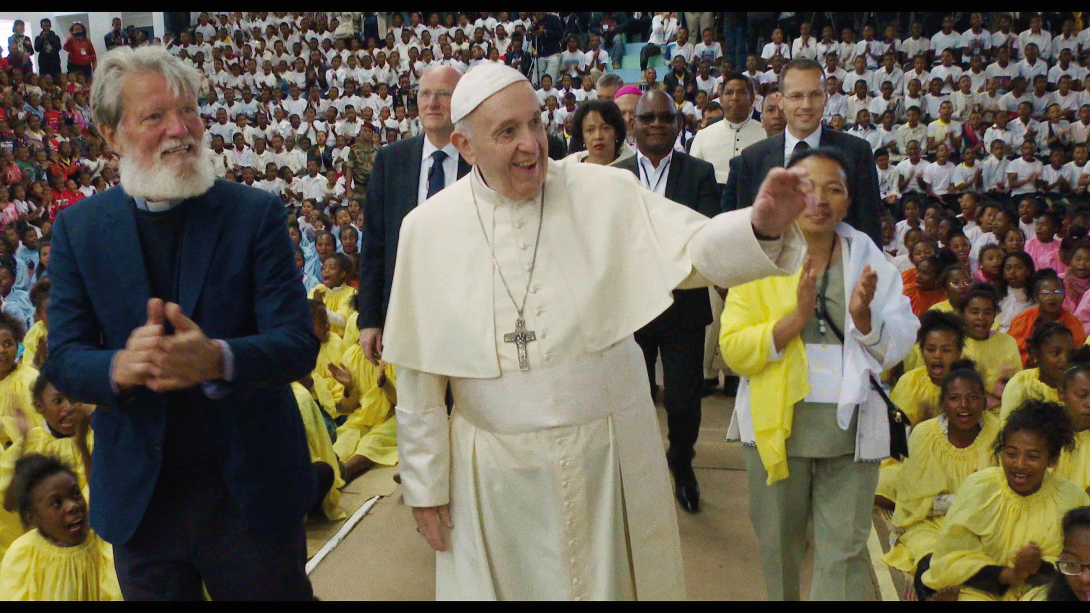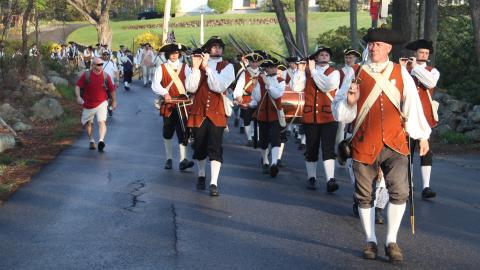“In Viaggio: The Travels of Pope Francis” shows previously unreleased footage of the Pope’ trips around the world

Photo by Archivo Vatican Media. Photo courtesy of Magnolia Pictures.
The telling pictures are often without any words: Pope Francis and Grand Ayatollah Ali Al-Sistani, sitting in silence during his visit to Iraq in March 2021, after showing the surrounding country that still bears the wounds of the war.
Intimate moments that the pope shared with people who suffer, like the long line of prisoners in Ciudad Juárez who come and greet Francis, dressed in their light blue uniforms.
In other moments, the viewer stands just behind the pope, who drives in an open vehicle through the crowds, an angle never seen on transmissions of the papal trips.
Gianfranco Rosi, director of the movie “In Viaggio,” sums up the first nine years of Francis’ pontificate. During these years, the pope made 37 trips and visited 53 countries, speaking about topics that are dear to him: poverty, solidarity, justice, mercy, peace.
The scenes show how he goes to the margins of society and doesn’t shy away from controversy. After he labelled the death of an estimated 800,000 to 1.2 million Armenians in the Ottoman Empire during World War I a genocide, Rosi shows the welcoming ceremony during his visit to Turkey without any words—no comment needed.
“I watched 800 hours of footage, and first, I was a spectator,” he said. Then he entered into the mind of the pope, whom he personally accompanied to Lampedusa, Iraq and Mexico. “There is an aspect in him that is very revolutionary,” the director says, referring to the famous “Who am I to judge?” phrase.
He met the pope recently in mid-March with his whole film crew, and Francis told him, “Risk, always risk. Be courageous and risk.”
Often during the 79-minute-long documentary, the director shows just pieces of the puzzle. The viewer has to put them together and try to come closer to Francis, the first pope of the Americas.
The documentary opens with the catastrophic shipwreck of the boat carrying migrants from Libya to Italy, which sank off the Italian island of Lampedusa in 2013, leaving more than 360 people drowned. It was Pope Francis’ first trip, and he went to pray and weep.
Among others, Rosi covers visits to the U.S., Mexico, Cuba, Israel, central Africa and the Philippines.
“First I wanted to do a very free movie, with no itinerary, no countries mentioned, starting in the Vatican and ending with the visit in Lampedusa. Then the war happened, and I went to Malta where he did this very strong speech. And I added this part as the last 10 minutes.
“Suddenly I realized what I did before didn’t make any more sense,” he said. “So then I started with Lampedusa and ended with the Pope’s warning, and as we did that, the film took its own way, it became tangible.”
With his premonition, the pope “always tells us something, but the words arrived to us later.”
Rosi, who declares himself to be a “secular person,” was fascinated by many images—when Pope Francis talks about dreams, or when he warns humanity against war. But the strongest image for him was the pope during the pandemic, alone on Good Friday 2020 in rainy St. Peter’s Square. “He didn’t speak to Catholics, or Protestants, he spoke to the whole world. He was reminding us what we are about to do to this world.”
Besides his firm “no” to war, building bridges is another leitmotif of Francis’ papacy. Meeting with leaders of other churches and religions, he aims to build bridges and point out that all faith communities have to work together.
“No proselytism,” he says while meeting Ecumenical Patriarch Bartholomew I. The Orthodox are our brothers and sisters.
The intimate footage of the pope between public appearances is moving. The images show vulnerability and exhaustion. He sits quietly in transit, shoulders hunched, his face without a smile, but in deep thought.
He carries the burdens of the scandals in his own house, professing shame over the long history of sexual abuse revealed within the Catholic Church and vowing that it will no longer be kept secret.
“God weeps,” he says, though again and again he has to answer uncomfortable questions as to why the Church and he himself did not react sooner.
In this way, the film bears witness to the physical transformation of that strong, energetic Francis elected in 2013 to the one who, in 2022, can walk only a few steps in great pain, an intimate glimpse into Francis’ personal journey.
“A portrait of a lonely man,” says Rosi.
Distributed in the U.S. by Magnolia Pictures. Producers: Gianfranco Rosi, Donatella Palermo. Crew: Director, writer, camera: Gianfranco Rosi. Editor: Fabrizio Federico. Running time: 79 minutes.
A scene from “In Viaggio”. The movie captures the pontiff with the masses, but also in quiet, reflective moments












